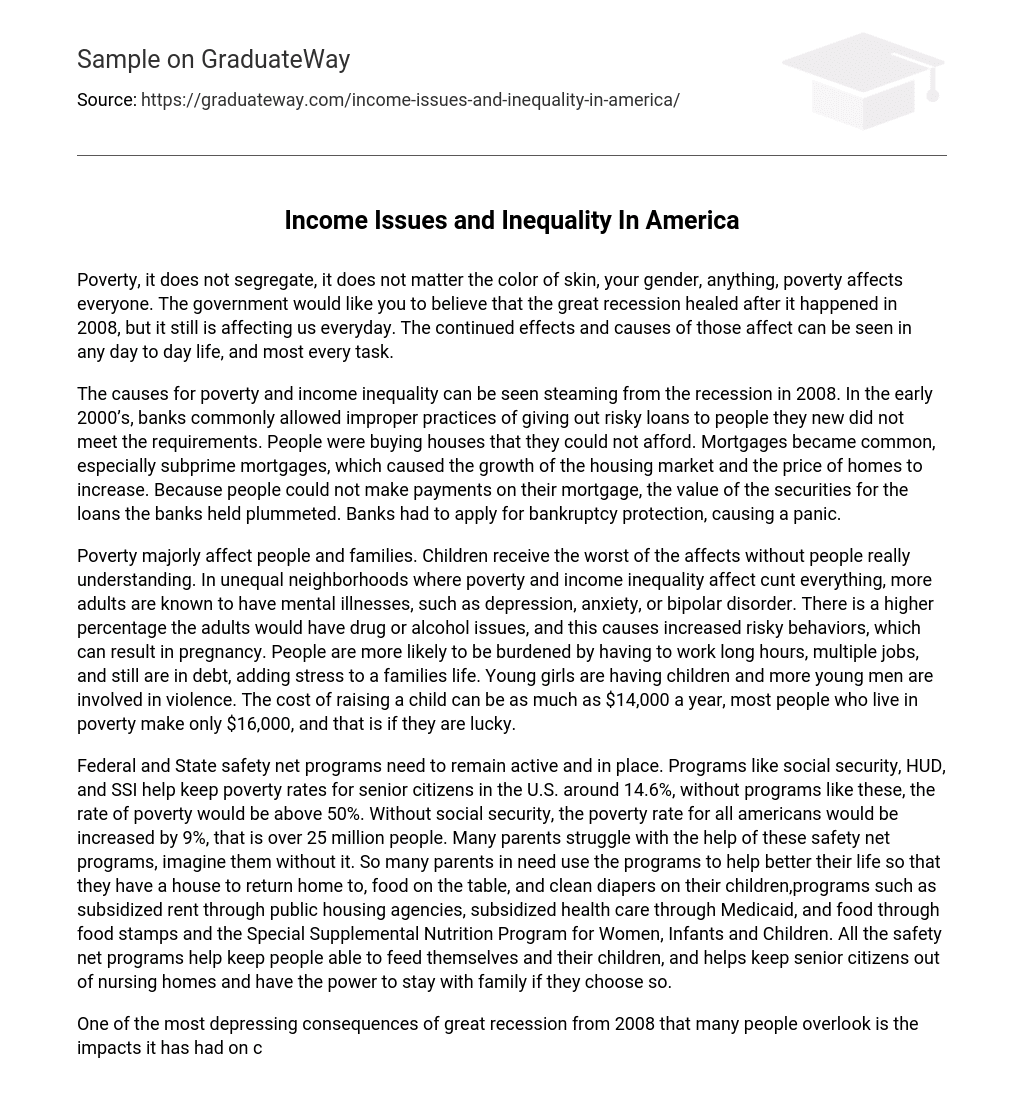Poverty, it does not segregate, it does not matter the color of skin, your gender, anything, poverty affects everyone. The government would like you to believe that the great recession healed after it happened in 2008, but it still is affecting us everyday. The continued effects and causes of those affect can be seen in any day to day life, and most every task.
The causes for poverty and income inequality can be seen steaming from the recession in 2008. In the early 2000’s, banks commonly allowed improper practices of giving out risky loans to people they new did not meet the requirements. People were buying houses that they could not afford. Mortgages became common, especially subprime mortgages, which caused the growth of the housing market and the price of homes to increase. Because people could not make payments on their mortgage, the value of the securities for the loans the banks held plummeted. Banks had to apply for bankruptcy protection, causing a panic.
Poverty majorly affect people and families. Children receive the worst of the affects without people really understanding. In unequal neighborhoods where poverty and income inequality affect cunt everything, more adults are known to have mental illnesses, such as depression, anxiety, or bipolar disorder. There is a higher percentage the adults would have drug or alcohol issues, and this causes increased risky behaviors, which can result in pregnancy. People are more likely to be burdened by having to work long hours, multiple jobs, and still are in debt, adding stress to a families life. Young girls are having children and more young men are involved in violence. The cost of raising a child can be as much as $14,000 a year, most people who live in poverty make only $16,000, and that is if they are lucky.
Federal and State safety net programs need to remain active and in place. Programs like social security, HUD, and SSI help keep poverty rates for senior citizens in the U.S. around 14.6%, without programs like these, the rate of poverty would be above 50%. Without social security, the poverty rate for all americans would be increased by 9%, that is over 25 million people. Many parents struggle with the help of these safety net programs, imagine them without it. So many parents in need use the programs to help better their life so that they have a house to return home to, food on the table, and clean diapers on their children,programs such as subsidized rent through public housing agencies, subsidized health care through Medicaid, and food through food stamps and the Special Supplemental Nutrition Program for Women, Infants and Children. All the safety net programs help keep people able to feed themselves and their children, and helps keep senior citizens out of nursing homes and have the power to stay with family if they choose so.
One of the most depressing consequences of great recession from 2008 that many people overlook is the impacts it has had on children and young adults lives during and growing up sense then. Any recessions can lead to high rates of child malnutrition, improper health due to poor or no diet, and there is massive amounts of evidence that points to extremely serious long term consequences to such malnutrition, including stunted developmental growth, and in mental growth; such as not being able to have high academic achievement and mental health disorders. Even for kids who did have enough to eat, the impacts can still be serious. Low income due to the income inequality for the parents can have a direct impact on the child’s education and enrichment opportunities. Too many young adults in school are finding college slipping out of reach due to their not being enough or any help from their parents because they are in debt, or from banks who can no longer afford to give out risky loans.
Income inequality does not affect based on race or gender, it affects everyone in different ways, it even affects geographical locations. In 1970, around 30% of all families living in large metropolitan areas lived in middle income neighborhoods. By 2012, over 40% of families lived in these neighborhoods. Families living in poor neighborhood have more than doubled, from 15% to 34% over a similar time period. The pattern of poverty is particularly problematic for lower income families and individuals because social mobility is so low. Social mobility is the movement of an individual, family, or even household through the social strata, or the classes, such as the lower class, middle class, and high class. It makes sense that neighborhoods characterized with higher poverty rates, lower employments, and more violence are extremely different from other neighborhoods that live in wealth and within protected areas. Economic inequality based on spatial dimensions is a continuing feature of the United States cities and communities that dies not seem to be going away. The amount at which residential sorting is continuously increasing, matching the steady rise of income inequality. Over 35% of all households in large urban areas live in poor, low income neighborhoods.





